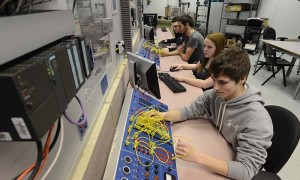The health care industry is getting more technologically advanced every year. And with those advances, comes a need for people who not only understand how to use the technology, but can help make innovations that will continue to advance the system.
One of the degrees that can put you at the heart of all the action is a health information technology degree. This type of degree program will teach you how to use technology to collect, analyze, monitor, maintain and report health data. If you’re interested in the medical field, a health information technology program offers a truly fascinating point from which to explore your passions and start your career.
In the classroom and in the field, when you’re enrolled in a health information technology program, you’ll learn to process requests for the release of personal health information, code clinical information, process and use health data for clinical quality management, bill patients for services (and provide reimbursement) and learn compliance while protecting patient privacy. And frankly, the jobs you’ll receive after you receive your health information technology degree will put you in a position of great responsibility and control.
Post-Health Information Technology Program Jobs
With the degree in hand, some of the positions you can expect to work in include:
o Health Information Technician. Job responsibilities often include reviewing medical charts to check for completion and accuracy, generating reports and assigning diagnosis codes to medical charts for insurance claims and data collection purposes, plus gathering, analyzing and managing information about patients so healthcare providers can properly care for them.
o Medical Coder. With a health information technology degree you can enter the field as a medical coder, which, because of its medical and business nature, is often a springboard for advancement opportunities within the healthcare sector. Some of the responsibilities of a medical coder include reviewing medical documents provided by physicians, then translating the information into numeric codes and sequencing diagnostic and procedural codes by using a standard healthcare coding system. This work is crucial to the financial reimbursement of healthcare professionals by the insurance companies that provide policies for the patients.
o Health Information Administrator. After completing a health information technology program you may work as a healthcare administrator. In this position you will oversee (or as an entry-level job assist the person who oversees) the business of providing services to patients and manage the health information systems that house the medical facility’s patient-related documents, insurance information, and business documentation.
o Medical Secretary. Medical secretaries help maintain order in the office and provide the support necessary for proper patient care. Some of the job responsibilities may include transcribing dictation, generating correspondence, assisting physicians with reports, speeches, articles, and conference proceedings, as well as providing technological support and maintaining medical records.










